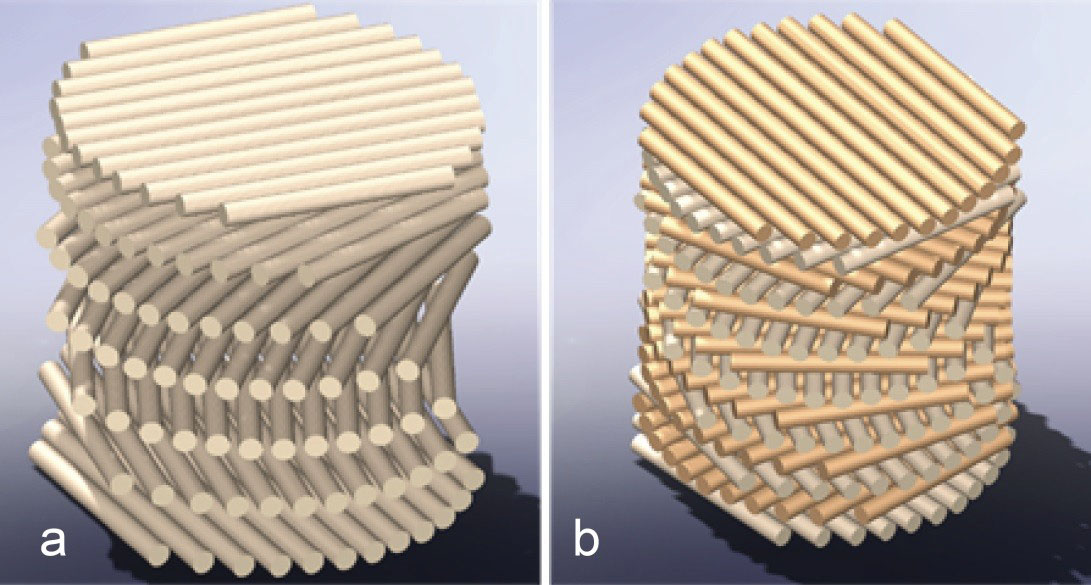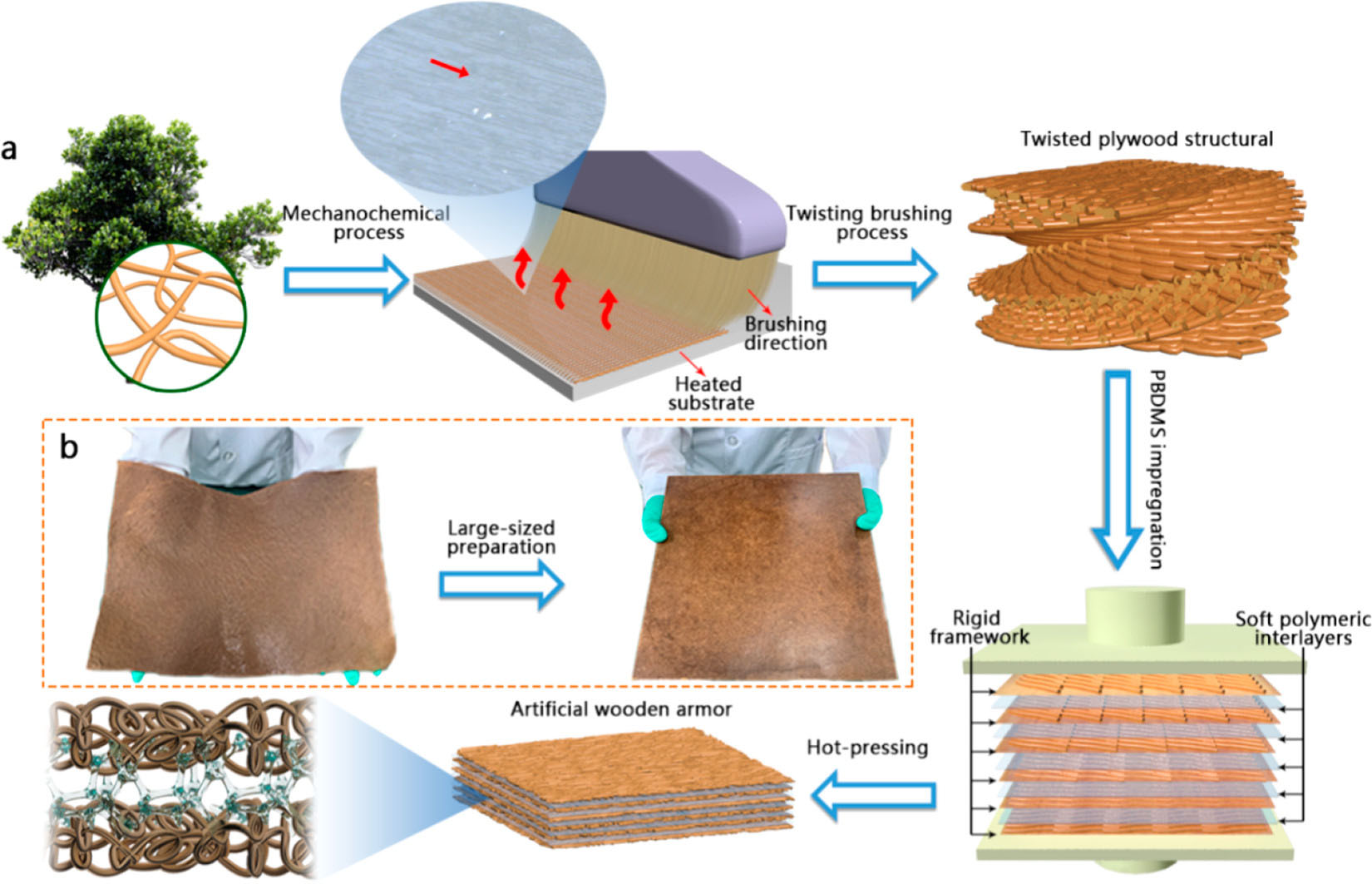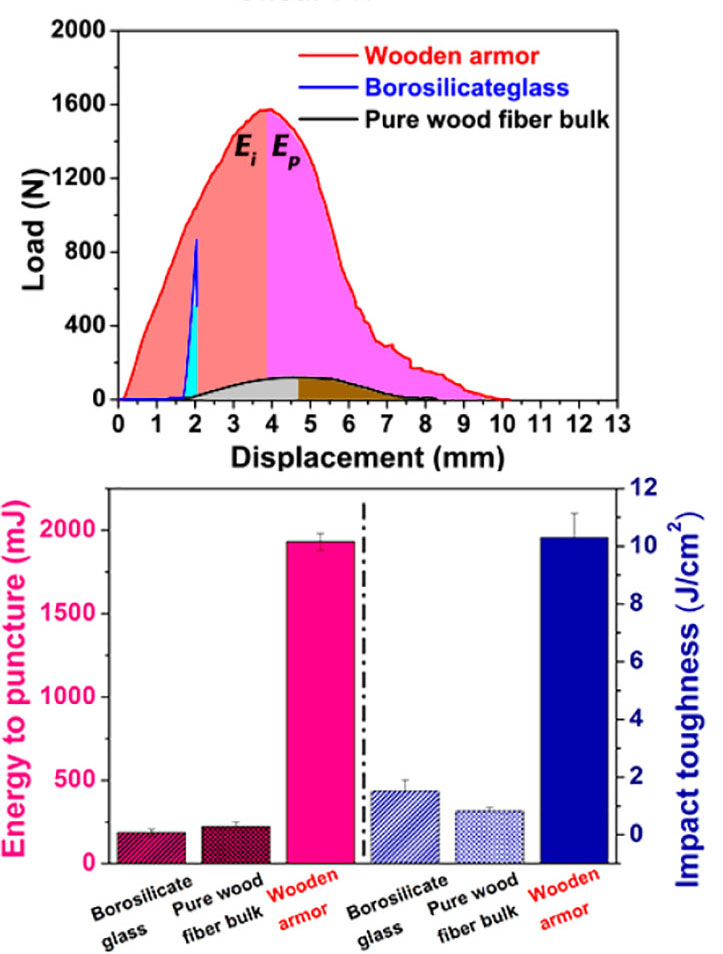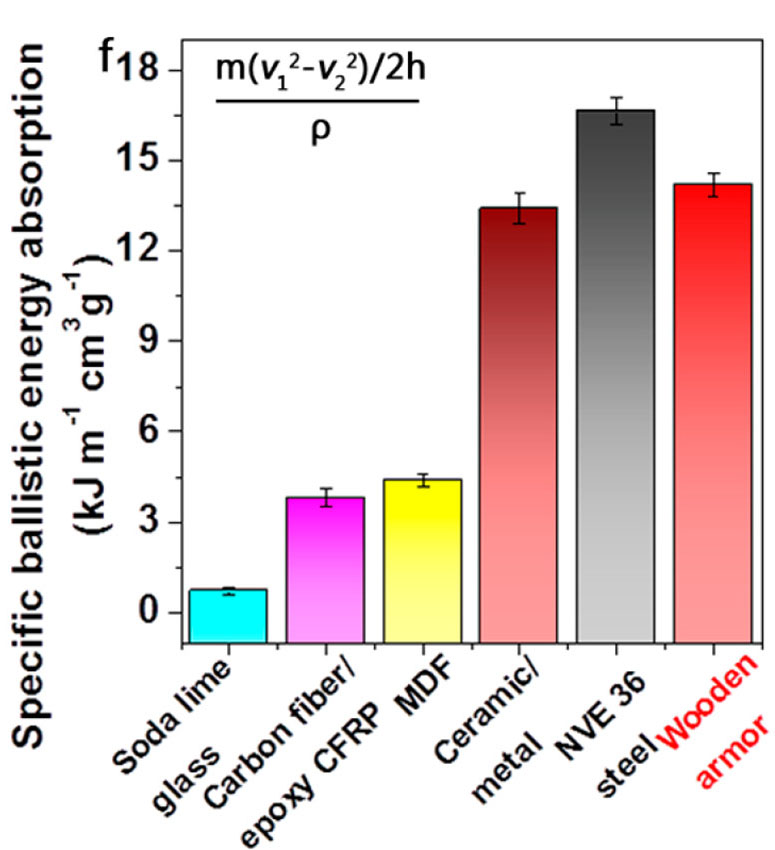| May 24, 2022 | |
Bio-inspired 'wooden armor' modeled on the structure of fish scales |
|
| (Nanowerk Spotlight) Man-made impact-resistant materials with exceptional mechanical performance are being widely used for military and civilian applications such as bullet-proof jackets, vehicle safety protection, bunkers, jet engines and much more. These materials include rolled homogeneous armor (RHA) steel, aluminum alloys, titanium based alloys, impact-resistant glass, ceramics (e.g., SiC, Al2O3, B4C, ceramic matrix composites (CMCs), and polymer matrix composites. | |
| However, these materials have several drawbacks such as a lack of flexibility, high weight, and high energy consumption during processing. | |
| Several biological materials and structures that are found in nature possess hierarchical microstructures with superb mechanical properties and they have inspired researchers to design lightweight, flexible and tough body armors without degrading their ballistic and blast protection performance. | |
| A few examples of biological composite structures are nacre (staggered multi-layer polygonal tablet’s structure), conch (cross-lamellar ceramic armor system), fish scales (flexible multi-layer armor system), crustacean exoskeleton (helicoidal fiber reinforced structural configuration) and cortical bone (multi-layer column-like structure with collagen fibers) (read more: "Inspiration from Nature's body armors – A review of biological and bio-inspired composites"). | |
| Recent studies suggest that fish skins, nacre, turtle shells, bird beaks, horns, shark teeth, and horse hooves possess fairly good impact-resistant properties (Biomimetic armor design strategies for additive manufacturing: A review). | |
| One interesting example is conch shell, which researchers have used as inspiration to devise a novel fabrication method using additive manufacturing to create a biomimetic conch shell prototype. It able to achieve improvements in impact resistance on demand by recreating the complex criss-crossed lamellar architecture found in natural conch shells (read more: "Hierarchically Enhanced Impact Resistance of Bio-inspired Composites"). | |
| Another interesting example is the Bouligand type structure found in Arapaima gigas, also known as pirarucu, which is a freshwater fish found in the Amazon Basin that is able to resist ferocious attacks by piranhas through the strength and toughness of their scales ("Mechanical adaptability of the Bouligand-type structure in natural dermal armor"). | |
| A Bouligand structure is a layered and rotated microstructure resembling plywood, which is frequently found in naturally designed materials. It consists of multiple lamellae, or layers, each one composed of aligned fibers. Adjacent lamellae are progressively rotated with respect to their neighbors. | |
 |
|
| Figure 1. Schematic illustrations of Bouligand structures. (a) Single Bouligand structure, typical of Arapaima gigas fish scales, and (b) the rarer double-twisted Bouligand structure, found in coelacanth fish. (Reprinted from doi:10.1016/j.jmps.2019.07.001, Lawrence Berkeley National Laboratory eScholarship open access) | |
| Wood is a low-cost and abundantly available material that has been used for thousands of years as a structural load-bearing material for tools, buildings, ships, furniture etc. However, the mechanical performance of natural wood – its strength and toughness – is not sufficient for many advanced engineering structures and applications. | |
| The mechanical performance of natural wood can be enhanced by pretreatment with steam, heat, ammonia, free radical initiation or acid catalysis or cold-rolling followed by densification ("Processing bulk natural wood into a high-performance structural material"). | |
| However, these existing methods result in incomplete densification and a lack in dimensional stability, particularly in response to humid environments. Wood treated in this way is susceptible to swelling and a loss of strength. | |
| Lignocellulose – the main component of plant biomass and nature's equivalent to armored concrete – is a complex natural biomaterial at nano- and microscales ("Lignocellulosic Biomass: Understanding Recalcitrance and Predicting Hydrolysis"). | |
| Lignocellulosic materials have three main structural polymer components: cellulose, hemicelluloses, and lignin. Cellulose and hemicellulose are carbohydrate polymers, while lignin is a non-carbohydrate phenolic polymer that binds to cellulose fibers to harden and strengthened the plant cell walls. | |
| These three components are radically different chemically and are interconnected in a very complex fashion. The majority of the densified wood comprises well aligned cellulose nanofibers, which to a great extent enhance hydrogen bond formation among neighboring nanofibers. | |
| In the plant cell wall, hemicellulose is linked to cellulose by hydrogen bonds and to lignin by covalent bonds forming lignin-carbohydrate complexes (LCC). These innumerable hydrogen bonds impart the materials with great strength and toughness. Lignocellulose is also composed of relatively low density parenchyma cells that create a soft foam-like structure, which makes it lightweight in nature. | |
| The authors of a recent paper in ACS Nano ("Bio-inspired Construction of Micronano Lignocellulose into an Impact Resistance “Wooden Armor” With Bouligand Structure") propose the design and development of a bio-inspired, high strength and high toughness lignocellulose-based material that can serve as a 'wood armor'. | |
| The researchers' processing route involves laying one-dimensional (1D) lignocellulose nanofibrils in a flexible manner to compose two-dimensional (2D) films with unidirectional assemblies. Aligned lignocellulose fibers were obtained by brushing-induced assembly, followed by dipping in shear thickening fluid (by using polyborosiloxane (PBDMS)), and subsequently, efficiently hot-pressing into a macroscopic three-dimensional (3D) body. | |
 |
|
| Figure 2. (a) Bottom-up assembly strategy of the artificial wooden armor. (b) A large scale 2D film and 3D artificial wooden armor. (Reprinted with permission from doi:10.1021/acsnano.1c10725, ACS Nano, ©2022, American Chemical Society) | |
| The obtained artificial wooden armor has biomimetic flexible-rigid layered Bouligand-like structures similar to the scales of pirarucu. Its impact resistance is comparable to that of conventional engineering materials such as ceramics, glass, and alloys. It is noteworthy that the density of the wooden armor is approximately only half that of these materials. | |
| Additionally, the ease of deformation of the secondary hydrogen bonds in artificial wooden armor maintains its structural integrity during impact damage, and this in turn circumvents the catastrophic damage that occurs in glass and ceramics, which is attributable to the presence of primary (covalent) bonds. | |
 |
|
| Figure 3. Top: Puncture force−displacement curves. Bottom: Energy to puncture and Charpy impact toughness of the artificial wooden armor, pure wood fiber bulk, and borosilicate glass, respectively. (Reprinted and adapted with permission from doi:10.1021/acsnano.1c10725, ACS Nano, ©2022, American Chemical Society) | |
| Figure 3 (top) reveals the typical puncture force−displacement curves of the bio-inspired wooden armor, pure wood fiber bulk, and borosilicate glass (where Ei represents the energy associated with the elastic deformation before crack initiation and Ep represents plastic energy absorbed during crack propagation). The ultimate puncture force obtained from the force−displacement curves of the initial stage indicates the ability to resist deformation in elastic regime along with a damage propagation stage. | |
| The Ei of the wooden armor was higher than that of the composite without Bouligand structure, which is ascribed to its soft-rigid dual layered network interactions and a multitude of deformation mechanisms. The ultimate puncture force increased significantly when PBDMS was introduced – by ∼13 times-from 119.1 N (pure wood fiber bulk) to 1570.7 N (artificial wooden armor) – evidently implying the high ductility and energy-absorbing capacity of the PBDMS. | |
| The researchers attributed the performance of the wooden armor to its structural features at multiple micro-nanoscale levels where the shear thickening soft components play a key role. In terms of energy to puncture (Figure 3, bottom), borosilicate glass showed the lowest energy absorption during puncture, pure wood fiber bulk displayed slightly improved energy absorption due to its ductile nature and the artificial wooden armor showed greater toughness with large strain resulting in high energy absorption during the course of its puncture. | |
| Wooden armor exhibited improvement in energy to puncture and impact toughness by 10.4% and 12.4%, respectively, compared with pure wood fiber bulk. | |
| Mechanical tests showed the optimal amount of PBDMS to be ∼10 wt % in order for wood armor to achieve the most desirable energy to puncture (Figure 3, bottom) with a film thickness of ∼65 µm. | |
| To assess the ballistic impact characteristics of the wooden armor and other competitive materials, ballistic tests were performed using a revolver and 9 mm caliber ammunition with an impact velocity of 214 m/s. | |
| The wood armor maintained superior integrity arising from the complicated helicoidal structure architecture and the high deformability of the PBDMS interlayers (Figure 4). Although, medium-density fiberboard (MDF) and carbon-fiber-reinforced polymers (CRPF) are lightweight, they were easily perforated during ballistic impact tests showing poor ballistic resistance performance. The NVE 36 metallic alloy – a high quality structural steel plate commonly used in the shipbuilding industry – exhibits the highest impact resistance with a relatively high density. | |
 |
|
| Figure 4: Comparison of specific ballistic energy absorption of the artificial wooden armor with other common structural materials. The equation inset is for the specific ballistic energy absorption, where v1 and v2 are the velocities of the bullet before and after passing through the sample, m is the mass of bullet, and h and ρ are the thickness and density of the sample, respectively. (Reprinted and adapted with permission from doi:10.1021/acsnano.1c10725, ACS Nano, ©2022, American Chemical Society) | |
| The test showed that artificial wooden armor is able to withstand the potentially lethal blow of high-speed bullets and is competitive with conventional engineered impact resistant ceramics, glass, and alloys – although with just half the density and at a much lighter weight. | |
| The authors are confident that their bottom−up strategy for fabricating synthetic wood armor will inspire and provide feasible routes to designing and developing cost-effective, lightweight, biodegradable, and environmentally sustainable materials for impact protection in engineering fields such as aviation, space exploration, deep-sea exploration, military protection, and other fields that involve extreme conditions. | |
|
By Yashwant Mahajan, Associate Editor, Nanowerk
|
|
|
Become a Spotlight guest author! Join our large and growing group of guest contributors. Have you just published a scientific paper or have other exciting developments to share with the nanotechnology community? Here is how to publish on nanowerk.com. |
|
